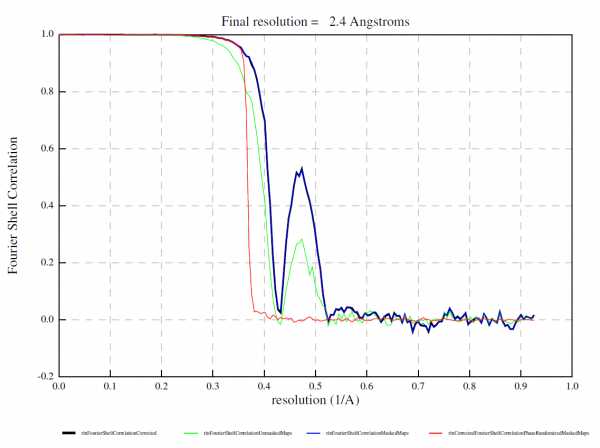Pixel size issues
How can I merge datasets with different pixel sizes?
Please see an excellent explanation posted to CCPEM by Max Wilkinson: https://www.jiscmail.ac.uk/cgi-bin/webadmin?A2=CCPEM;fd0e7fab.1810.
What should I do if the pixel size turned out to be wrong?
If the error is small (say 1-2 %) and the resolution is not very high (3 Å), you can specify the correct pixel size in the PostProcess job. This scales the resolution in the FSC curve. You should not edit your STAR files because your current defocus values are fitted against the initial, slightly wrong pixel size. Also, you should not use "Manually set pixel size" in the Extraction job. It will make metadata inconsistent and break Bayesian Polishing.
When the error is large, the presence of spherical aberration invalidates this approach. Continue reading.
Cs and the error in the pixel size
Recall that the phase shift due to defocus is proportional to the square of the wave number (i.e. inverse resolution), while that due to spherical aberration is proportional to the forth power of the wave number. At lower resolutions, the defocus term dominates and errors in the pixel size (i.e. errors in the wave number) can be absorbed into the defocus value fitted at the nominal pixel size. At higher resolution, however, the Cs term becomes significant. Since Cs is not fitted but given at the correct pixel size, the error persists. As the two terms have the opposite sign, the errors sometimes cancel out at certain resolution shells, leading to a strange bump in the FSC curve. See an example below contributed from a user. Here the pixel size was off by about 6 % (truth: 0.51 Å / px, nominal: 0.54 Å / px).
Below is a theoretical consideration. Let's consider a CTF at defocus 5000 Å, Cs 2.7 mm at 0.51 Å / px. This is shown in orange. If one thought the pixel size is 0.54 Å / px, the calculated CTF (blue) became quite off even at 5 Å (0.2).
However, the defocus is fitted (by CtfFind, followed by CtfRefine) at 0.54 Å / px, the nominal pixel size. The defocus became 5526 Å, absorbing the error in the pixel size. This is shown in blue. The fit is almost perfect up to about 3.3 Å. In this region, you can update the pixel size in PostProcess. Beyond this point, the error from the Cs term starts to appear and the two curves goes out of phase. This is why the FSC drops to zero. However, the two curves came into phase again at about 1.8 Å (1.55)! This is why the FSC goes up again.
If you refine Cs and defocus simultaneously, the error in the pixel size is completely absorbed and the fit becomes perfect. Notice that the refined Cs is 3.39, which is 2.7 * (0.54 / 0.51)^4. Also note that the refined defocus 5606 Å is 5000 * (0.54 / 0.51)^2.
In this case, one could change the Cs in the STAR file to 3.39 and re-run CtfRefine. Now everything is consistent at the nominal pixel size of 0.54 Å/px. In PostProcess, one should specify 0.51 Å/px to re-scale the resolution and the header of the output map.
